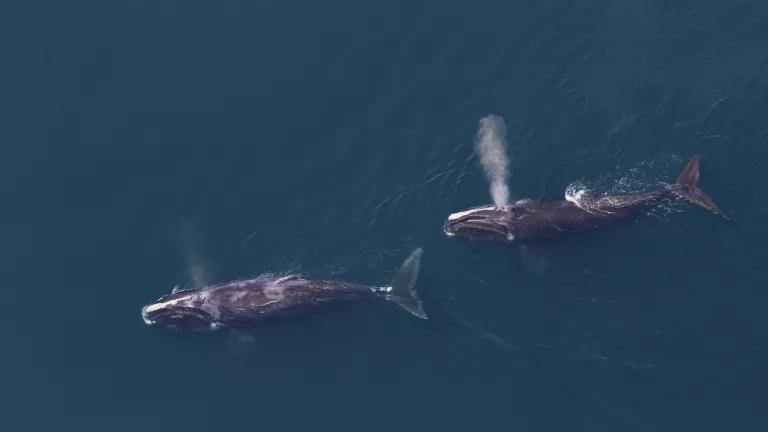South Fork Wind Adopts Enhanced Right Whale Protections
A new wind project offshore New York will include added protections for the endangered North Atlantic right whale.

A new wind project offshore New York will include added protections for the endangered North Atlantic right whale.
© NOAA Fisheries
A new conservation agreement ensures that an offshore wind project set to supply New York with enough renewable power for 70,000 homes incorporates important enhanced protections for the endangered North Atlantic right whale.
South Fork Wind’s commercial offshore wind project plans to start providing much-needed clean energy to Long Island homes and businesses by the end of next year—and project construction and operations now include smart new protections for the critically endangered North Atlantic right whale.
An agreement—between South Fork Wind (a joint venture developed by Ørsted and Eversource), NRDC, the National Wildlife Federation, and the Conservation Law Foundation—expands beyond the company’s formal Record of Decision with the U.S. government. The agreement incorporates measures to further safeguard the health of the North Atlantic right whale, including:
- A 10-knot speed limit in right whale habitat for all project-related vessels throughout the project’s lifetime unless an equally effective, scientifically-proven adaptive speed management plan is in place. Even a single vessel strike from any boat operating anywhere on the water has major ramifications on the ability of the North Atlantic right whale species to survive. Slower speeds significantly reduce the chance of death and serious injury to whales and sea turtles from vessel strikes.
- Stronger monitoring measures during noisy construction activities to allow endangered North Atlantic right whales to feed and migrate undisturbed. Underwater noise can injure animals that are nearby, or drive them away from preferred habitats and interfere with their abilities to feed, communicate and detect predators. Visual and acoustic monitoring—with the right amount of area clearance and observers near the construction site paired to the amount of noise emitted—is key to protecting whales from harmful noise pollution. Added visual monitoring measures at South Fork Wind means more trained protected species observer eyes on the water, helping alert engineers to nearby whales.
With fewer than 340 individuals remaining, the North Atlantic right whale is in precarious straits. The species is rapidly declining due to vessel strikes and fishing gear entanglements and faces a multitude of additional threats, including underwater noise pollution and malnourishment, all while fighting to adapt to climate change. With the species simply unable to withstand further loss or disturbance, the right whale crisis is not a problem caused by the offshore wind industry, but it is one the industry must face.
The South Fork Wind agreement shows we don’t need to choose between clean energy development and wildlife protection. South Fork Wind will now serve as a pilot program for these more rigorous right whale provisions, providing enhanced protective measures at the start of this new U.S. industry.
We need offshore wind, and we need to do it right. Offshore wind is critical to reaching our national climate goals, promising healthier air and creating thousands of well-paying clean energy jobs.
But as we fight climate change, we can and must avoid, minimize, and mitigate threats to ocean life. Taking action to avoid, minimize, and mitigate impacts on the North Atlantic right whale is key to ensuring offshore wind development is done in a smart way that protects our valuable and vulnerable wildlife.





